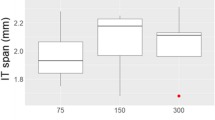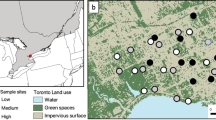Abstract
Bees are the most important pollinator taxon; therefore, understanding the scale at which they forage has important ecological implications and conservation applications. The foraging ranges for most bee species are unknown. Foraging distance information is critical for understanding the scale at which bee populations respond to the landscape, assessing the role of bee pollinators in affecting plant population structure, planning conservation strategies for plants, and designing bee habitat refugia that maintain pollination function for wild and crop plants. We used data from 96 records of 62 bee species to determine whether body size predicts foraging distance. We regressed maximum and typical foraging distances on body size and found highly significant and explanatory nonlinear relationships. We used a second data set to: (1) compare observed reports of foraging distance to the distances predicted by our regression equations and (2) assess the biases inherent to the different techniques that have been used to assess foraging distance. The equations we present can be used to predict foraging distances for many bee species, based on a simple measurement of body size.


Similar content being viewed by others
References
Axelrod DI (1960) The evolution of flowering plants. In: Tax S (ed) Evolution after Darwin: the evolution of life, vol 1. University of Chicago Press, Chicago, IL
Bacon OG, Burton VE, McSwain JW, Marble VL, Stanger W, Thorp RW (1965) Pollinating alfalfa with leaf-cutting bees (AXT 160). University of California Agricultural Extension Service, Berkeley, CA
Bawa KS (1990) Plant–pollinator interactions in tropical rain forests. Annu Rev Ecol Syst 21:299–422
Beekman M, Ratnieks FLW (2000) Long-range foraging by the honey-bee, Apis mellifera L. Funct Ecol 14:490–496
Campbell DR (1985) Pollen and gene dispersal—the influences of competition for pollination. Evolution 39:418–431
Cane JH (1987) Estimation of bee size using intertegular span (Apoidea). J Kans Entomol Soc 60:145–147
Collett TS (1996) Insect navigation en route to the goal: multiple strategies for the use of landmarks. J Exp Biol 199:227–235
Cresswell JE, Osborne JL, Goulson D (2000) An economic model of the limits to foraging range in central place foragers with numerical solutions for bumblebees. Ecol Entomol 25:249–255
Cunningham SA (2000) Depressed pollination in habitat fragments causes low fruit set. Proc R Soc Lond B 267:1149–1152
Darvill BM, Knight E, Goulson D (2004) Use of genetic markers to quantify bumblebee foraging range and nest density. Oikos 107:471–478
Dick CW (2001) Genetic rescue of remnant tropical trees by an alien pollinator. Proc R Soc Lond B 268:2391–2396
Dyer FC, Seeley TD (1991) Dance dialects and foraging range in three Asian honey bee species. Behav Ecol Sociobiol 28:227–233
Fabre JH (1914) The mason bees. Dodd, Mead and Co., New York
Gary NE, Witherell PC, Marston J (1972) Foraging range and distribution of honey bees used for carrot and onion pollination. Environ Entomol 1:71–78
Gathmann A, Tscharntke T (2002) Foraging ranges of solitary bees. J Anim Ecol 71:757–764
Greenleaf SS, Kremen C (2006) Wild bee species increase tomato production and respond differently to surrounding land use in Northern California. Biol Conserv 133:81–87
Greenleaf SS, Kremen C (2006b) Wild bees enhance honey bees’ pollination of hybrid sunflower. Proc Natl Acad Sci USA 103:13890–13895
Harestad AS, Bunnell FL (1979) Home range and body-weight—re-evaluation. Ecology 60:389–402
Harrison JF, Roberts SP (2000) Flight respiration and energetics. Annu Rev Physiol 62:179–205
Haskell JP, Ritchie ME, Olff H (2002) Fractal geometry predicts varying body size scaling relationships for mammal and bird home ranges. Nature 418:527–530
Holling CS (1992) Cross-scale morphology, geometry, and dynamics of ecosystems. Ecol Monogr 62:447–502
Jenkins SH (1981) Common patterns in home range—body size relationships of birds and mammals. Am Nat 118:126–128
Jetz W, Carbone C, Fulford J, Brown JH (2004) The scaling of animal space use. Science 306:266–268
Judd GJR, Borden JH (1989) Distant olfactory response of the onion fly, Delia antiqua, to host-plant odor in the field. Physiol Entomol 14(4):429–441
Kapyla M (1978) Foraging distance of a small solitary bee, Chelostoma maxillosum (Hymenoptera, Megachilidae). Ann Entomologici Fenn 35:63–64
Kelt DA, Van Vuren DH (2001) The ecology and macroecology of mammalian home range area. Am Nat 157:637–645
Klein AM, Vaissière B, Cane JH, Steffan-Dewenter I, Cunningham SA, Kremen C, Tscharntke T (2007) Importance of crop pollinators in changing landscapes for world crops. Proc R Soc Lond Ser B 274:303–313
Klein AM, Steffan-Dewenter I, Tscharntke T (2003) Fruit set of highland coffee increases with the diversity of pollinating bees. Proc R Soc Lond Ser B 270:955–961
Klein AM, Steffan-Dewenter I, Tscharntke T (2003) Pollination of Coffea canephora in relation to local and regional agroforestry management. J Appl Ecol 40:837–845
Knight ME, Martin AP, Bishop S, Osborne JL, Hale RJ, Sanderson A, Goulson D (2005) An interspecific comparison of foraging range and nest density of four bumblebee (Bombus) species. Mol Ecol 14:1811–1820
Kremen C (2005) Managing ecosystem services: what do we need to know about their ecology? Ecol Lett 8:468–479
Kremen C, Williams NM, Thorp RW (2002) Crop pollination from native bees at risk from agricultural intensification. Proc Natl Acad Sci USA 99:16812–16816
Kremen C, Williams NM, Bugg RL, Fay JP, Thorp RW (2004) The area requirements of an ecosystem service, crop pollination. Ecol Lett 7:1109–1119
Lennartsson T (2002) Extinction thresholds and disrupted plant-pollinator interactions in fragmented plant populations. Ecology 83:3060–3072
McGregor SE (1976) Insect pollination of cultivated crop plants. US Department of Agriculture, Washington, DC
Makarieva AM, Gorshkov VG, Li B (2005) Why do population density and inverse home range scale differently with body size? Implications for ecosystem stability. Ecol Complexity 2:259–271
McNab BK (1963) Bioenergetics and the determination of home range size. Am Nat 97:133–140
Michener CD (1974) The social behavior of the bees, 2nd edn. Harvard University Press, Cambridge, MA
Milton K, May ML (1976) Body-weight, diet and home range area in primates. Nature 259:459–462
Murlis J, Elkinton JS, Carde RT (1992) Odor plumes and how insects use them. Annu Rev Entomol 37:505–532
Osborne JL, Clark SJ, Morris RJ (1999) A landscape-scale study of bumble bee foraging range and constancy, using harmonic radar. J Appl Ecol 36:519–533
Packer JS (1970) The flight and foraging behavior of the alkali bee (Nomia melanderi) and the alfalfa leaf-cutter bee (Megachile rotundata). Utah State University, Logan, UT, p 119
Quinn GP, Keough MJ (2002) Experimental design and data analysis for biologists. Cambridge University Press, Cambridge
Rau P (1929) Experimental studies in the homing of carpenter and mining bees. J Comp Psychol 9:35–70
Ricketts TH (2001) The matrix matters: effective isolation in fragmented landscapes. Am Nat 158:87–99
Ricketts TH (2004) Tropical forest fragments enhance pollinator activity in nearby coffee crops. Conserv Biol 18:1262–1271
Ritchie ME, Olff H (1999) Spatial scaling laws yield a synthetic theory of biodiversity. Nature 400:557–560
Robertson DR (1966) Observations on the alfalfa leaf-cutter bee Megachile rotundata at Hodgson, Manitoba in 1966. Proc Entomol Soc Manit 22:34–37
Roland J, Taylor PD (1997) Insect parasitoid species respond to forest structure at different spatial scales. Nature 386:710–713
Rossel S (1993) Navigation by bees using polarized skylight. Comp Biochem Physiol A 104(4):695–708
Schoener TW (1968) Sizes of feeding territories among birds. Ecology 49:123–141
Schone H, Kuhme WD (2001) Searching and homing times of displaced honeybees as affected by experience and celestial cues (Hymenoptera : Apidae). Entomol Generalis 25(3):171–180
Sokal RR, Rohlf FJ (1997) Biometry, 3rd edn. WH Freeman, New York
Southwick EE, Buchmann SL (1995) Effects of horizon landmarks on homing success in honey-bees. Am Nat 146(5):748–776
Steffan-Dewenter I, Kuhn A (2003) Honeybee foraging in differentially structured landscapes. Proc R Soc Lond Ser B Biol Sci 270:569–575
Turner FB, Jennrich RI, Weintrau JD (1969) Home ranges and body size of lizards. Ecology 50:1076–1081
Van Nieuwstadt MGL, Iraheta CER (1996) Relation between size and foraging range in stingless bees (Apidae, Meliponinae). Apidologie 27:219–228
Walther-Hellwig K, Frankl R (2000) Foraging distances of Bombus muscorum, Bombus lapidarius, and Bombus terrestris (Hymenoptera, Apidae). J Insect Behav 13:239–246
Waser NM, Chittka L, Price MV, Williams NM, Ollerton J (1996) Generalization in pollination systems and why it matters. Ecology 77:1043–1060
Westphal C, Steffan-Dewenter I, Tscharntke T (2006) Bumblebees experience landscapes at different spatial scales: possible implications for coexistence. Community Ecol 149:289–300
Westrich P (1996) Considering the ecological needs of our native bees and the problems of partial habitats. In: Matheson A, Buchmann SL, O’Toole C, Westrich P, Williams IH (eds) The conservation of bees. Academic, London
Acknowledgments
John Ascher provided updates to bee species names. B. Danforth provided comments on the manuscript. T. Good translated selected research papers from German to English. C O’Toole provided unpublished data. We measured IT span on specimens provided by the American Museum of Natural History (New York, NY), the Bohart Museum of the University of California (Davis, CA), the USDA Bee Biology and Systematics lab (Logan, UT) and the Smithsonian Institution (Washington, DC). Funding was provided by an Environmental Protection Agency Science to Achieve Results Fellowship to SSG, a David H. Smith Conservation Research Fellowship to NMW, a postdoctoral fellowship from the Princeton Council on Science and Technology to RW, a McDonnell 21st Century Research Award to CK, and the Princeton University Ecology and Evolutionary Biology Department.
Author information
Authors and Affiliations
Corresponding author
Additional information
Communicated by Richard Karban.
Electronic supplementary material
Below is the link to the electronic supplementary material.
Rights and permissions
About this article
Cite this article
Greenleaf, S.S., Williams, N.M., Winfree, R. et al. Bee foraging ranges and their relationship to body size. Oecologia 153, 589–596 (2007). https://doi.org/10.1007/s00442-007-0752-9
Received:
Revised:
Accepted:
Published:
Issue Date:
DOI: https://doi.org/10.1007/s00442-007-0752-9




